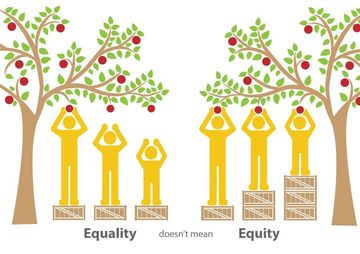
By many measures, life sciences companies have made progress improving diversity and inclusion (D&I) across the industry. However, one component of a comprehensive D&I strategy is often misunderstood at best and forgotten about at worst: equity.
Diversity, inclusion, equity, and equality are often used interchangeably, but they should not be – each has a specific meaning. After meeting with dozens of company leaders I’ve found that some are confused by the distinction and some have difficulty using these terms to generate meaningful, lasting action.
For the purpose of this article we are going to focus on equality vs. equity and discuss why equity is important, and how it impacts our industry.
Equality is when everyone is treated the same way and have equal opportunities to contribute and excel. However, equality is based on an assumption that we all started at the same place and need the same tools to be successful. That’s where equity comes in.
Equity is about leveling the playing field recognizing that we all don’t begin at the same point and some people do have built-in advantages. Without it, you can’t effectively acknowledge structural ‘isms’ (sexism, racism, ableism, ageism) that negatively impact our industry and our communities, ultimately making D&I initiatives less sustainable. After all, you can’t fix a problem without addressing the root of the issue.
 Why does ‘equity’ matter?
Why does ‘equity’ matter?
Equity is not about compliance (reactive and transactional). It is about commitment (proactive and transformational). Equity, diversity & inclusion (ED&I) is about the full deployment of a variety of resources for better outcomes that benefit everyone in a sustainable way – employees, the organization, and thus, the patient community.
What impact does equity have on the industry and society?
Without a proactive commitment to equity, a company’s D&I efforts will not be impactful or sustainable. Hiring and retaining diverse talent is only the first step. Equity will ensure that all employees have the same opportunity for promotions and future success.
With so many organizations in the life sciences focused on improving D&I, we must consider why we haven’t achieved the depth of change that we seek. Inequity exists as a result of years of hiring practices that have historically excluded marginalized groups. Creating an inclusive culture through equity requires an intentional, adaptive, and transformational approach that impacts behaviors and mindsets, as well as policies, practices, and programs.
Equity means more than treating persons in the same way – it requires action on and the accommodation of differences. At a minimum, an equitable workplace has transparency in hiring, promotions, consequences, and rewards. But it must also provide the training and professional development opportunities needed to correct the conditions that created disadvantages for these marginalized groups. Only then can a workplace encourage a sense of belonging and authenticity for all its employees.
Here are some real-world examples from MassBio members:
- Member A reported that their equity efforts have led to:
- A 95% retention rate of those who participated in a six-month mentoring program;
- The appointment of two senior female executives to corporate boards; and
- An increase in the number of diverse Medical Science Liaisons to work with clinical researchers and drive more diverse participation in clinical trials.
- Member B’s ‘Sponsorship Plan’ develops senior leaders and advances careers. Over the course of a year, the person being sponsored meets with an executive coach once a month and shadows key leaders and receives their feedback. This goal of this initiative is to bridge the skills gap and diversify the senior ranks.
- Member C is transparent about reporting ED&I metrics across business units and feels that this brings accountability. Internal transparency builds trust and confidence, while external transparency allows a company to lead by example.
Having a diverse workforce within an inclusive and equitable environment contributes to increased retention, innovation, and productivity; an organization’s responsiveness to an ever-evolving diverse world; and the industry’s ability to cope with change. By building inclusive cultures through equity, we can begin to dismantle the structural ‘isms’. Only then will we truly live up to our missions.
This article originally appeared in the Winter 2019 Issue of The MassBio Insider, MassBio's new magazine.